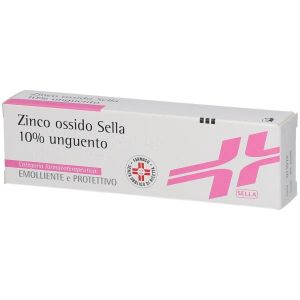Ship in Europe, Find out rates!

Sella Zinc Oxide Ointment 10% Protective 10% 30g
SELLA
Therapeutic indications
Soothing and protective treatment of eczema, dermatosis and slight abrasions.
Dosage
Apply the ointment locally, 1 or 2 times a day, on properly washed and dried skin. Due to its astringent and decongestant action it can also be used on irritated skin (for example diaper rash). Apply a layer of ointment to cover the affected area (especially when used to treat diaper rash); in case of sunburn and non-infected skin lesions, it is preferable to apply a thin layer of ointment, using a bandage if necessary. Perform a light circular massage on the affected area, in order to obtain a partial absorption of the ointment, following which an opaque white residue remains.
Overdose
No cases of overdose have been reported. Poor percutaneous absorption of the drug makes overdose symptoms and signs unlikely. In case of accidental ingestion, the following symptoms may be encountered: diarrhea, nausea and vomiting, hypoglycemia, confusion, fatigue, lethargy, bleeding, jaundice, dark urine, cough, chills and fever, irritation of the oral cavity, kidney problems, copper deficiency.
Contraindications
Hypersensitivity to the active substance or to any of the excipients.
Side effects
The following are the undesirable effects of zinc oxide organized according to the MedDRA system organ class. Insufficient data are available to establish the frequency of the individual effects listed. Immune system disorders Allergic / hypersensitivity reaction: rash, hives, itching and / or swelling (mainly of the face, tongue, throat, lips), tightness in the chest, difficulty in breathing. Skin and subcutaneous tissue disorders Skin irritation. Burning, tingling and dark spots on the skin.
Pregnancy and breastfeeding
Generally, the use of the ointment during pregnancy and breastfeeding is considered safe when applied to small areas and for short periods of time. Pregnancy No clinical data on exposed pregnancies are available for zinc oxide ointment. This medicine, if used in accordance with the instructions for use, is not absorbed and therefore does not cause systemic effects; in case of damaged skin, it can be absorbed in minimal quantities. Breastfeeding There are no data on the use of zinc oxide ointment during breastfeeding and it is not known whether this active ingredient passes into breast milk. However, as the absorption of the drug can be considered negligible, it is very unlikely that significant quantities reach the breast milk.
Special warnings
The medicine is to be used for external use only; it may be harmful if swallowed (see section 4.9). Avoid contact of the drug with the eyes; in case of accidental contact, wash abundantly with water. Do not use the medicine in case of burns or potentially infected wounds. If the ointment is used for diaper rash, check that the rash improves within a few days; if not, a different treatment must be used. The use, especially if prolonged, of medicines for local use can give rise to phenomena of irritation or sensitization. In this case, treatment must be stopped and appropriate therapy instituted. Important information about some of the ingredients : - Methyl parahydroxybenzoate (E218): can cause allergic reactions (even delayed).
Expiry and Retention
In tightly closed package, away from heat.
Active principles
100 g of ointment contain Active ingredient: zinc oxide 10.0 g. For the full list of excipients, see section 6.1.
Excipients
White petroleum jelly, liquid paraffin, methyl parahydroxybenzoate (E218).